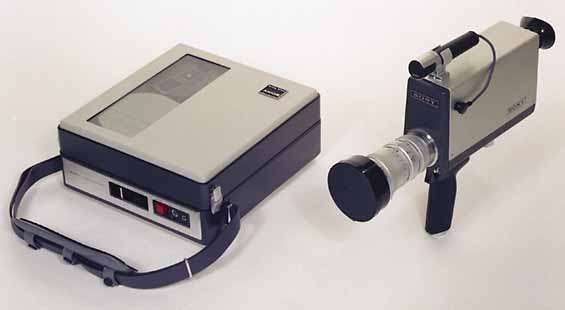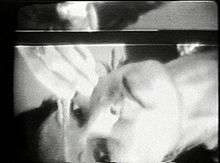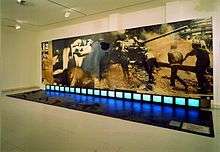Video art
Video art is an art form which relies on using video technology as a visual and audio medium. Video art emerged during the late 1960s as new consumer video technology such as video tape recorders became available outside corporate broadcasting. Video art can take many forms: recordings that are broadcast; installations viewed in galleries or museums; works streamed online, distributed as video tapes, or DVDs; and performances which may incorporate one or more television sets, video monitors, and projections, displaying live or recorded images and sounds.[1]

Video art is named for the original analog video tape, which was the most commonly used recording technology in much of the form history into the 1990s. With the advent of digital recording equipment, many artists began to explore digital technology as a new way of expression.
One of the key differences between video art and theatrical cinema is that video art does not necessarily rely on many of the conventions that define theatrical cinema. Video art may not employ the use of actors, may contain no dialogue, may have no discernible narrative or plot, or adhere to any of the other conventions that generally define motion pictures as entertainment. This distinction also distinguishes video art from cinema's subcategories such as avant garde cinema, short films, or experimental film.
Early history
Nam June Paik, a Korean-American artist who studied in Germany, is widely regarded as a pioneer in video art.[2][3] In March 1963 Nam June Paik showed at the Galerie Parnass in Wuppertal the Exposition of Music – Electronic Television.[4][5] In May 1963 Wolf Vostell showed the installation 6 TV Dé-coll/age at the Smolin Gallery in New York and created the video Sun in your head in Cologne. Originally Sun in your head was made on 16mm film and transferred 1967 to videotape.[6][7][8]
Video art is often said to have begun when Paik used his new Sony Portapak to shoot footage of Pope Paul VI's procession through New York City in the autumn of 1965[9] Later that same day, across town in a Greenwich Village cafe, Paik played the tapes and video art was born.

Prior to the introduction of consumer video equipment, moving image production was only available non-commercially via 8mm film and 16mm film. After the Portapak's introduction and its subsequent update every few years, many artists began exploring the new technology.
Many of the early prominent video artists were those involved with concurrent movements in conceptual art, performance, and experimental film. These include Americans Vito Acconci, Valie Export, John Baldessari, Peter Campus, Doris Totten Chase, Maureen Connor, Norman Cowie, Dimitri Devyatkin, Frank Gillette, Dan Graham, Gary Hill, Joan Jonas, Bruce Nauman, Nam June Paik, Bill Viola, Shigeko Kubota, Martha Rosler, William Wegman, and many others. There were also those such as Steina and Woody Vasulka who were interested in the formal qualities of video and employed video synthesizers to create abstract works. Kate Craig,[10] Vera Frenkel[11] and Michael Snow[12] were important to the development of video art in Canada.
In the 1970s
Much video art in the medium's heyday experimented formally with the limitations of the video format. For example, American artist Peter Campus' Double Vision combined the video signals from two Sony Portapaks through an electronic mixer, resulting in a distorted and radically dissonant image. Another representative piece, Joan Jonas' Vertical Roll, involved recording previously-recorded material of Jonas dancing while playing the videos back on a television, resulting in a layered and complex representation of mediation.

Much video art in the United States was produced out of New York City, with The Kitchen, founded in 1972 by Steina and Woody Vasulka (and assisted by video director Dimitri Devyatkin and Shridhar Bapat), serving as a nexus for many young artists. An early multi-channel video art work (using several monitors or screens) was Wipe Cycle by Ira Schneider and Frank Gillette. Wipe Cycle was first exhibited at the Howard Wise Gallery in New York in 1969 as part of an exhibition titled "TV as a Creative Medium". An installation of nine television screens, Wipe Cycle combined live images of gallery visitors, found footage from commercial television, and shots from pre-recorded tapes. The material was alternated from one monitor to the next in an elaborate choreography.

On the West coast, the San Jose State television studios in 1970, Willoughby Sharp began the "Videoviews" series of videotaped dialogues with artists. The "Videoviews" series consists of Sharps’ dialogues with Bruce Nauman (1970), Joseph Beuys (1972), Vito Acconci (1973), Chris Burden (1973), Lowell Darling (1974), and Dennis Oppenheim (1974). Also in 1970, Sharp curated "Body Works", an exhibition of video works by Vito Acconci, Terry Fox, Richard Serra, Keith Sonnier, Dennis Oppenheim and William Wegman which was presented at Tom Marioni's Museum of Conceptual Art, San Francisco, California.
In Europe, Valie Export's groundbreaking video piece, "Facing a Family" (1971) was one of the first instances of television intervention and broadcasting video art. The video, originally broadcast on the Austrian television program "Kontakte" February 2, 1971,[11] shows a bourgeois Austrian family watching TV while eating dinner, creating a mirroring effect for many members of the audience who were doing the same thing. Export believed the television could complicate the relationship between subject, spectator, and television.[13] In the United Kingdom David Hall's "TV Interruptions" (1971) were transmitted intentionally unannounced and uncredited on Scottish TV, the first artist interventions on British television.
1980s-1990s
As the prices of editing software decreased, the access the general public had to utilize these technologies increased. Video editing software became so readily available that it changed the way digital media artists and video artists interacted with the mediums. Different themes emerged and were explored in the artists work, such as interactivity and nonlinearity. Criticisms of the editing software focused on the freedom that was created for the artists through the technology, but not for the audience. Some artists combined physical and digital techniques to allow their audience to physically explore the digital work. An example of this is Jeffrey Shaw's "Legible City" (1988–91). In this piece the "audience" rides a stationary bicycle through a virtual images of Manhattan, Amsterdam, and Karlsrule. The images change depending on the direction of the bike handles, and the speed of the pedaler. This created a unique virtual experience for every participant.
After 2000
As technology and editing techniques have evolved since the emergence of video as an art form, artists have been able to experiment more with video art without using any of their own content. Marco Brambilla's "Civilization" (2008) shows this technique. Brambilla attempts to make a video version of a collage, or a "video mural" [14] by combining various clips from movies, and editing them to portray heaven and hell.[15]
There are artists today who have changed the way video art is perceived and viewed. In 2003, Kalup Linzy created Conversations Wit De Churen II: All My Churen, a soap opera satire that has been credited as creating the video and performance sub-genre 'Theatre of the Self, Performing who you are'. Although Linzy's work is genre defying his work has been a major contribution to the medium. Ryan Trecartin, and experimental young video-artist, uses color, editing techniques and bizarre acting to portray what the New Yorker calls "a cultural watershed".[16][17] Trecartin played with the portrayal of identity and ended up producicng characters who "can be many people at the same time".[16] When asked about his characters, Trecartin explained that he visualized that each person's identity was made up of "areas" and that they could all be very different from each other and be expressed at different times.[16] Ryan Trecartin is an innovative artist who has been said to have "changed the way we engage with the world and with one another"[17] through video art. A series of videos made by Trecartin titled I-BE-AREA displayed this, one example is I-BE-AREA (Pasta and Wendy M-PEGgy), which was made public in 2008, which portrays a character named Wendy who behaves erratically. When asked about his characters, Trecartin explained that he visualized that each person's identity was made up of "areas" and that they could all be very different from each other and be expressed at different times.[16] Ryan Trecartin is an innovative artist who has been said to have "changed the way we engage with the world and with one another"[17] through video art. In 2008, New York Times Holland Cotter writes, 'A big difference between his work and Mr. Trecartin's is in the degree of digital engagement. Mr. Trecartin goes wild with editing bells and whistles; Mr. Linzy does not. The plainness and occasional clunkiness of his video technique is one reason the Braswell serial ends up touching in a way that Mr. Trecartin's buzzed-up narratives rarely are. For all their raunchy hilarity Mr. Linzy's characters are more than cartoons; “All My Churen” is a family-values story that has a lot to do with life.[18]
Performance art and video art
Video art as a medium can also be combined with other forms of artistic expression such as Performance art. This combination can also be referred to as "media and performance art" [19] when artists "break the mold of video and film and broaden the boundaries of art".[19] With increased ability for artists to obtain video cameras, performance art started being documented and shared across large amounts of audiences.[20] Artists such as Marina Abramovic and Ulay experimented with video taping their performances in the 1970s and the 1980s. In a piece titled “Rest energy” (1980) both Ulay and Marina suspended their weight so that they pulled back a bow and arrow aimed at her heart, Ulay held the arrow, and Marina the bow. The piece was 4:10 which Marina described as being “a performance about complete and total trust”.[21]
Other artists who combined Video art with Performance art used the camera as the audience. Kate Gilmore experimented with the positioning of the camera. In her video “Anything” (2006) she films her performance piece as she is constantly trying the reach the camera which is staring down at her. As the 13-minute video goes on, she continues to tie together pieces of furniture while constantly attempting to reach the camera. Gilmore added an element of struggle to her art which is sometimes self-imposed,[22] in her video “My love is an anchor” (2004) she lets her foot dry in cement before attempting to break free on camera.[23] Gilmore has said to have mimicked expression styles from the 1960s and 1970s with inspirations like Marina Abramovic as she adds extremism and struggle to her work.[24]
Some artists experimented with space when combining Video art and Performance art. Ragnar Kjartannson, an Icelandic artist, filmed an entire music video with 9 different artists, including himself, being filmed in different rooms. All the artists could hear each other through a pair of headphones so that they could play the song together, the piece was titled "The visitors" (2012).[25]
Notable video art organizations
- Ars Electronica Center (AEC), Linz, Austria
- Edith-Russ-Haus for Media Art, Oldenburg, Germany
- Electronic Arts Intermix, New York, NY
- Experimental Television Center, New York
- Goetz Collection, Munich, Germany
- Imai – inter media art institute, Düsseldorf
- Impakt Festival, Utrecht
- Julia Stoschek Collection, Düsseldorf, Germany
- Kunstmuseum Bonn, large video art collection
- LA Freewaves is an experimental media art festival with video art, shorts and animation; exhibitions are in Los Angeles and online.
- Lumen Eclipse – Harvard Square, MA
- LUX, London, UK
- London Video Arts, London, UK
- Perpetual art machine, New York
- Raindance Foundation, New York
- Souvenirs from Earth, Art TV Station on European Cable Networks (Paris, Cologne)
- Vtape, Toronto, Canada
- Videoart at Midnight, an artists' cinema project, Berlin, Germany
- Video Data Bank, Chicago, IL.
- VIVO Media Arts Centre, Vancouver, Canada
- ZKM Center for Art and Media Karlsruhe, Germany
- Videobrasil, Associação Cultural Videobrasil, São Paulo, Brazil
See also
| Wikimedia Commons has media related to Video art. |
| Wikiquote has quotations related to: Video art |
- Artmedia
- Experimental film
- INFERMENTAL
- Interactive film
- List of video artists
- Music video
- Music visualization
- New media art
- Optical feedback
- Real-time computer graphics
- Scratch video
- Single-channel video
- Sound art
- Video jockey
- Video poetry
- Video sculpture
- Video synthesizer
- Visual music
- VJ (video performance artist)
References
- Hartney, Mick. "Video art" Archived 2011-10-17 at the Wayback Machine, MoMA, accessed January 31, 2011
- "Archived copy" (PDF). Archived (PDF) from the original on 2016-03-04. Retrieved 2016-05-16.CS1 maint: archived copy as title (link)
- Judkis, Maura (12 December 2012). "Nam June Paik at the Smithsonian American Art Museum opens Dec. 13". washingtonpost.com. Archived from the original on 9 August 2017. Retrieved 9 May 2018.
- Netz, Medien Kunst (9 May 2018). "Medien Kunst Netz - Exposition of Music – Electronic Television". www.medienkunstnetz.de. Archived from the original on 9 August 2017. Retrieved 9 May 2018.
- Net, Media Art (9 May 2018). "Media Art Net - Exhibition unknown". www.medienkunstnetz.de. Archived from the original on 9 August 2017. Retrieved 9 May 2018.
- NBK Band 4. Time Pieces. Videokunst seit 1963. Verlag der Buchhandlung Walther König, Köln, 2013, ISBN 978-3-86335-074-1
- Net, Media Art (9 May 2018). "Media Art Net - Vostell, Wolf: Television Décollage". www.medienkunstnetz.de. Archived from the original on 11 May 2012. Retrieved 9 May 2018.
- Net, Media Art (9 May 2018). "Media Art Net - Vostell, Wolf: Sun in Your Head". www.medienkunstnetz.de. Archived from the original on 8 October 2017. Retrieved 9 May 2018.
- Laura Cumming (December 19, 2010), Nam June Paik – review Archived 2016-11-26 at the Wayback Machine Nam June Paik The Guardian.
- Marsh, James H (1985-01-01). The Canadian encyclopedia. Edmonton: Hurtig Publishers. ISBN 088830269X. OCLC 12578727.
- "Vera Frenkel: Archive Fevers - Canadian Art". Canadian Art. Archived from the original on 2016-10-22. Retrieved 2016-10-22.
- Elwes, Catherine (2006-04-26). Video Art, A Guided Tour: A Guided Tour. I.B.Tauris. ISBN 9780857735959. Archived from the original on 2018-05-09.
- "Electronic Arts Intermix: Facing a Family, Valie Export". eai.org. Archived from the original on 2010-12-25.
- "Marco Brambilla: Civilization". Motionographer. 2009-03-16. Archived from the original on 2018-03-31. Retrieved 2018-03-03.
- "Civilization (Hell and Heaven) by Marco Brambilla". www.seditionart.com. Archived from the original on 2018-03-31. Retrieved 2018-03-03.
- Tomkins, Calvin (2014-03-17). "Experimental People". The New Yorker. ISSN 0028-792X. Archived from the original on 2018-03-31. Retrieved 2018-03-30.
- Solway, Diane. "What You Need to Know About Lizzie Fitch and Ryan Trecartin, the Artists Behind Kendall and Gigi's W Cover Story". W Magazine. Archived from the original on 2018-03-31. Retrieved 2018-03-30.
- Cotter, Holland. "Video Art Thinks Big: That's Showbiz". Retrieved 2018-08-28.
- "MoMA | Performing for the Camera". www.moma.org. Archived from the original on 2018-03-31. Retrieved 2018-03-03.
- "MoMA | Performance into Art". www.moma.org. Archived from the original on 2017-12-15. Retrieved 2018-03-03.
- "Museum of Modern Art | MoMA". www.moma.org. Archived from the original on 2018-03-31. Retrieved 2018-03-02.
- "Kate Gilmore | LANDMARKS". landmarks.utexas.edu. Archived from the original on 2016-08-23. Retrieved 2018-03-02.
- "Break on Through". 2009-07-01. Archived from the original on 2018-03-20. Retrieved 2018-03-02.
- "Kate Gilmore: Body of Work | MOCA Cleveland". mocacleveland.org. Archived from the original on 2018-03-20. Retrieved 2018-03-03.
- "Art Star Ragnar Kjartansson Moves People To Tears, Over And Over". NPR.org. Archived from the original on 2018-03-31. Retrieved 2018-03-02.
Further reading
- Making Video 'In' - The Contested Ground of Alternative Video On The West Coast Edited by Jennifer Abbott (Satellite Video Exchange Society, 2000).
- Videography: Video Media as Art and Culture by Sean Cubitt (MacMillan, 1993).
- A History of Experimental Film and Video by A. L. Rees (British Film Institute, 1999).
- New Media in Late 20th-Century Art by Michael Rush (Thames & Hudson, 1999).
- Mirror Machine: Video and Identity, edited by Janine Marchessault (Toronto: YYZ Books, 1995).
- Sounding the Gallery: Video and the Rise of Art Music by Holly Rogers (New York: Oxford University Press, 2013).
- Video Culture: A Critical Investigation, edited by John G. Hanhardt (Visual Studies Workshop Press, 1986).
- Video Art: A Guided Tour by Catherine Elwes (I.B. Tauris, 2004).
- A History of Video Art by Chris Meigh-Andrews (Berg, 2006)
- Diverse Practices: A Critical Reader on British Video Art edited by Julia Knight (University of Luton/Arts Council England, 1996)
- ARTFORUM FEB 1993 "Travels In The New Flesh" by Howard Hampton (Printed by ARTFORUM INTERNATIONAL 1993)
- Resolutions: Contemporary Video Practices', (eds. Renov, Michael & Erika Suderburg) (London, Minneapolis: University of Minnesota Press,1996).
- Expanded Cinema by Gene Youngblood (New York: E.P. Dutton & Company, 1970).
- The Problematic of Video Art in the Museum 1968-1990 by Cyrus Manasseh (Cambria Press, 2009).
- "First Electronic Art Show" by (Niranjan Rajah & Hasnul J Saidon) (National Art Gallery, Kuala Lumpur, 1997)
- "Expanded Cinema", (David Curtis, A. L. Rees, Duncan White, and Steven Ball, eds), Tate Publishing, 2011
- "Retrospektiv-Film-org videokunst| Norge 1960-90". Edited by Farhad Kalantary & Linn Lervik. Atopia Stiftelse, Oslo, (April 2011).
- Experimental Film and Video, Jackie Hatfield, Editor. (John Libbey Publishing, 2006; distributed in North America by Indiana University Press)
- "REWIND: British Artists' Video in the 1970s & 1980s", (Sean Cubitt, and Stephen Partridge, eds), John Libbey Publishing, 2012.
- Reaching Audiences: Distribution and Promotion of Alternative Moving Image by Julia Knight and Peter Thomas (Intellect, 2011)
- Wulf Herzogenrath: Videokunst der 60er Jahre in Deutschland, Kunsthalle Bremen, 2006, (No ISBN).
- Rudolf Frieling & Wulf Herzogenrath: 40jahrevideokunst.de: Digitales Erbe: Videokunst in Deutschland von 1963 bis heute, Hatje Cantz Verlag, 2006, ISBN 978-3-7757-1717-5.
- NBK Band 4. Time Pieces. Videokunst seit 1963. Verlag der Buchhandlung Walther König, Köln, 2013, ISBN 978-3-86335-074-1.
- Demolden Video Project: 2009-2014. Video Art Gallery, Santander, Spain, 2016, ISBN 978-84-16705-40-5.
- Valentino Catricalà, Laura Leuzzi, Cronologia della videoarte italiana, in Marco Maria Gazzano, KINEMA. Il cinema sulle tracce del cinema. Dal film alle arti elettroniche andata e ritorno, Exorma, Roma 2013.